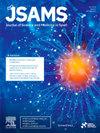The kinetics of cardiac troponin T release during and after 1- and 6-h maximal cycling trials
IF 3
2区 医学
Q1 SPORT SCIENCES
引用次数: 0
Abstract
Objectives
In this study, the effects of short-duration high-intensity exercise and long-duration exercise on high-sensitivity cardiac troponin T (hs-cTnT) levels were compared.
Methods
Twelve male amateur cyclists performed 1- and 6-h cycling trials. In both exercise trials, hs-cTnT was assessed at rest, immediately postexercise and at 1, 3, 6, 12, and 24 h postexercise. Additionally, hs-cTnT levels were assessed every hour during the 6-h trial.
Results
Exercise resulted in an increase in hs-cTnT levels in all subjects. Circulating hs-cTnT levels increased in both exercise trials (p < 0.001), with higher peak values occurring after the 1-h trial compared with those of the 6-h trial (p = 0.023). The upper reference limit (URL) exceeded 83 % of the participants in the 1-h trial and 42 % of the participants in the 6-h trial. There was substantial individual variability in peak hs-cTnT in both trials. Values of hs-cTnT were greater after exercise than during exercise for the 6-h trial. For both exercise trials, the maximum postexercise hs-cTnT values correlated with the %HRMAX (r = 0.906 for the 1-h trial, r = 0.735 for the 6-h trial). For the 1-h trial, the maximum postexercise hs-cTnT values were observed at 3 h in all subjects. No significant difference in the hs-cTnT values was observed for the 6-h trial during the first 12 h postexercise.
Conclusions
Our results demonstrated greater hs-cTnT levels in young male participants after a 1-h cycling trial than after a 6-h cycling trial, despite a substantially greater energy expenditure and total external work completed in the 6-h trial. Postexercise hs-cTnT values are associated with relative exercise intensity.
心肌肌钙蛋白 T 在 1 小时和 6 小时最大骑行试验期间和之后的释放动力学
本研究比较了短时高强度运动和长时间运动对高敏心肌肌钙蛋白 T(hs-cTnT)水平的影响。12 名男性业余自行车运动员分别进行了 1 小时和 6 小时的自行车试验。在这两项运动试验中,hs-cTnT 均在休息时、运动后立即以及运动后 1、3、6、12 和 24 小时进行评估。此外,在 6 小时的试验中,每隔一小时对 hs-cTnT 水平进行一次评估。运动导致所有受试者的 hs-cTnT 水平升高。在两次运动试验中,循环中的 hs-cTnT 水平都有所上升(< 0.001),与 6 小时试验相比,1 小时试验后的峰值更高(= 0.023)。83%的 1 小时试验参与者和 42% 的 6 小时试验参与者超过了参考上限(URL)。在两次试验中,hs-cTnT 峰值的个体差异都很大。在 6 小时试验中,运动后的 hs-cTnT 值高于运动时的值。在这两项运动试验中,运动后 hs-cTnT 最大值与心率%相关(1 小时试验 = 0.906,6 小时试验 = 0.735)。在 1 小时试验中,所有受试者运动后 hs-cTnT 最大值均出现在 3 小时后。在运动后的前 12 小时内,6 小时试验的 hs-cTnT 值无明显差异。我们的研究结果表明,年轻男性参与者在 1 小时自行车运动后的 hs-cTnT 水平高于 6 小时自行车运动后的 hs-cTnT 水平,尽管 6 小时运动的能量消耗和完成的外部总工作量要大得多。运动后 hs-cTnT 值与相对运动强度有关。
本文章由计算机程序翻译,如有差异,请以英文原文为准。
求助全文
约1分钟内获得全文
求助全文
来源期刊
CiteScore
7.40
自引率
10.00%
发文量
198
审稿时长
48 days
期刊介绍:
The Journal of Science and Medicine in Sport is the official journal of Sports Medicine Australia (SMA) and is an an international refereed research publication covering all aspects of sport science and medicine.
The Journal considers for publication Original research and Review papers in the sub-disciplines relating generally to the broad sports medicine and sports science fields: sports medicine, sports injury (including injury epidemiology and injury prevention), physiotherapy, podiatry, physical activity and health, sports science, biomechanics, exercise physiology, motor control and learning, sport and exercise psychology, sports nutrition, public health (as relevant to sport and exercise), and rehabilitation and injury management. Manuscripts with an interdisciplinary perspective with specific applications to sport and exercise and its interaction with health will also be considered.

 求助内容:
求助内容: 应助结果提醒方式:
应助结果提醒方式:


